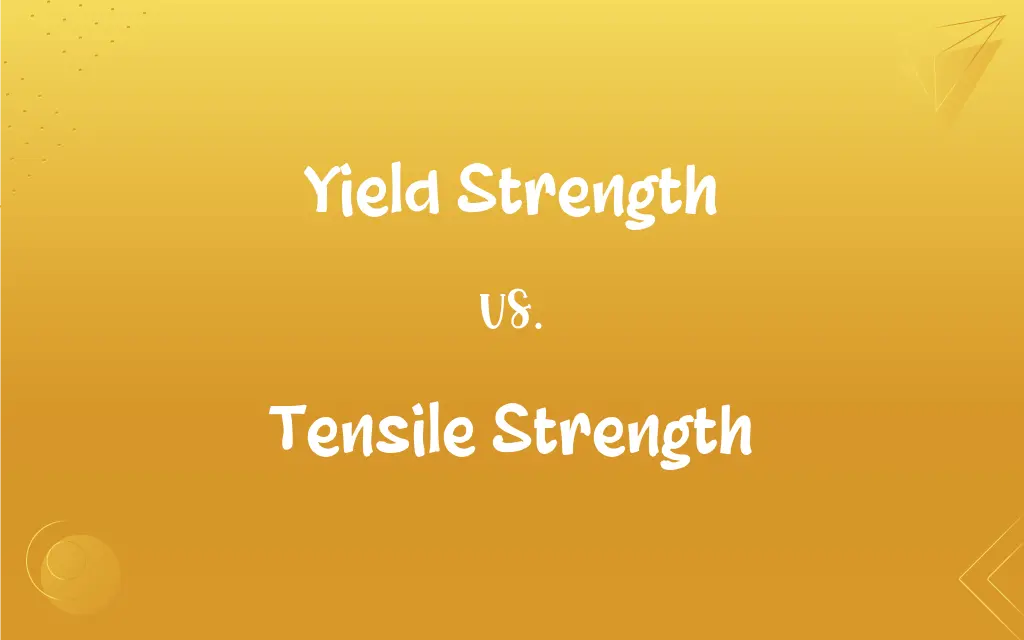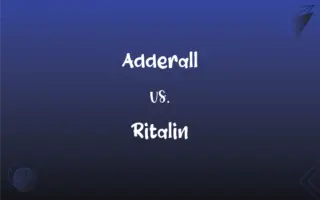Yield Strength vs. Tensile Strength: What's the Difference?
Edited by Janet White || By Harlon Moss || Updated on October 4, 2023
Yield strength refers to the stress at which a material deforms permanently, while tensile strength indicates the maximum stress it can withstand before breaking.

Key Differences
Yield strength is a critical parameter in material science. It denotes the point where a material, when subjected to stress, begins to deform irreversibly. In contrast, tensile strength is the stress level at which materials break or fracture when stretched.
Both yield strength and tensile strength are measures of a material's resistance to mechanical failure, but they signify different behaviors. Yield strength highlights the onset of plastic deformation, while tensile strength signifies the point of outright failure.
Engineers and designers often consider yield strength when determining how a material will respond under load without undergoing permanent deformation. Tensile strength, on the other hand, guides them in understanding the material's overall breaking limit.
In metals, yield strength can often be identified as the point at which the material starts to show significant elongation without additional applied force. Tensile strength is typically where the metal experiences fracture or complete failure.
Materials often have a yield strength that's lower than their tensile strength. This means they'll start deforming at the yield strength, but only break or snap at the tensile strength.
ADVERTISEMENT
Comparison Chart
Definition
Stress at which material deforms permanently
Maximum stress before material breaks
Importance
Indicates onset of plastic deformation
Indicates point of complete failure
Visual Clue
Start of significant elongation
Point of fracture
Value
Typically lower than tensile strength
Typically higher than yield strength
Application
Considered for permanent deformation under load
Considered for overall breaking limit
ADVERTISEMENT
Yield Strength and Tensile Strength Definitions
Yield Strength
A measure indicating the onset of plastic deformation in a material.
Before reaching its yield strength, the metal will return to its original shape.
Tensile Strength
The stress point at which materials fracture when stretched.
Despite its flexibility, rubber has a definable tensile strength.
Yield Strength
The threshold of non-elastic behavior in materials under stress.
The beam displayed signs of yielding, indicating it surpassed its yield strength.
Tensile Strength
The utmost force a material can bear without rupture.
The metal's high tensile strength made it ideal for bridge cables.
Yield Strength
The maximum stress a material can handle without permanent deformation.
Surpassing the yield strength can result in irreversible structural changes.
Tensile Strength
A property defining a material's breaking point when under tension.
The fabric's tensile strength is crucial for its use in parachutes.
Yield Strength
A property indicating the resilience of materials before plastic deformation.
Engineers ensure structures operate below their yield strength for safety.
Tensile Strength
A measure of material's resistance to being pulled apart.
Diamond has a high tensile strength, making it hard to break.
Yield Strength
The stress point where materials begin to deform irreversibly.
The steel's yield strength was exceeded, leading to a permanent bend.
Tensile Strength
The maximum amount of stress a material can endure before breaking.
The rope's tensile strength ensures it can support the weight without snapping.
FAQs
What happens if a material is stressed beyond its tensile strength?
It will break or fracture.
Can a material regain its shape after exceeding its yield strength?
No, exceeding the yield strength results in permanent deformation.
How is tensile strength different from yield strength?
Tensile strength is the maximum stress a material can handle before breaking, while yield strength is the point of permanent deformation.
Why is yield strength significant for engineers?
It helps engineers determine how much stress a material can handle without undergoing permanent deformation.
Can a material have the same yield and tensile strengths?
While rare, some materials can have very close values, but typically the tensile strength is higher.
Is tensile strength related to hardness?
While both are measures of resistance to deformation, they are different properties; a material can be hard but not necessarily have high tensile strength.
Why might some materials lack a clear yield point?
Some materials, especially non-metals, might undergo gradual deformation without a distinct yield point.
How are yield and tensile strengths used in safety protocols?
Structures and tools are designed to operate below these values to avoid failure and potential hazards.
How do these strengths relate to ductility?
A material's range between its yield and tensile strengths often relates to its ductility or its ability to deform without breaking.
What is yield strength?
It's the stress at which a material starts to deform permanently.
Why might a material deform without breaking?
It may have reached its yield strength but not its tensile strength.
What role does temperature play in these strengths?
Both yield and tensile strengths can vary with temperature, often decreasing with increased temperature.
How do impurities affect yield and tensile strengths?
Impurities can act as stress concentrators, often reducing these strengths.
Why might an engineer be concerned with tensile strength over yield strength?
If the primary concern is preventing material breakage rather than deformation, tensile strength becomes more critical.
How are yield and tensile strengths measured?
They are typically measured using standardized tension tests on material samples.
Are yield and tensile strengths important for all materials?
Yes, they're crucial for understanding material behavior under different stresses.
Can tensile strength be improved through processing?
Yes, processes like tempering or alloying can enhance tensile strength.
Do all materials have a definable yield strength?
Most do, but some materials, like ceramics, might fracture before showing clear yielding.
Are these strengths relevant for compressive loads?
Yield and tensile strengths specifically address tensile (pulling) loads, but materials also have compressive yield and strength values for compressive (pushing) loads.
Can materials exhibit high tensile strength but low yield strength?
Yes, some materials can stretch considerably before breaking but deform permanently at lower stress levels.
About Author
Written by
Harlon MossHarlon is a seasoned quality moderator and accomplished content writer for Difference Wiki. An alumnus of the prestigious University of California, he earned his degree in Computer Science. Leveraging his academic background, Harlon brings a meticulous and informed perspective to his work, ensuring content accuracy and excellence.
Edited by
Janet WhiteJanet White has been an esteemed writer and blogger for Difference Wiki. Holding a Master's degree in Science and Medical Journalism from the prestigious Boston University, she has consistently demonstrated her expertise and passion for her field. When she's not immersed in her work, Janet relishes her time exercising, delving into a good book, and cherishing moments with friends and family.































































